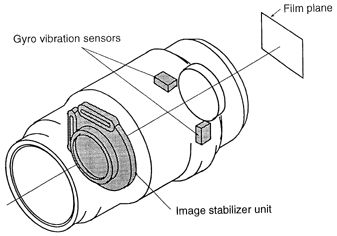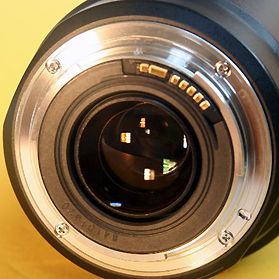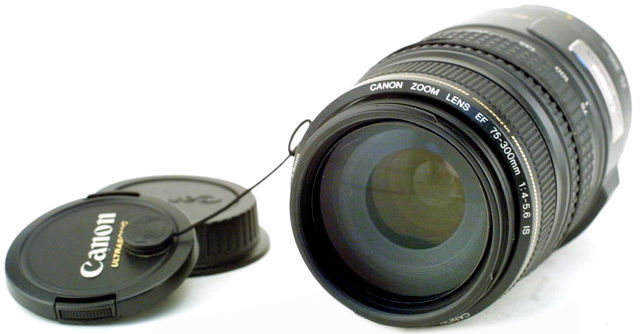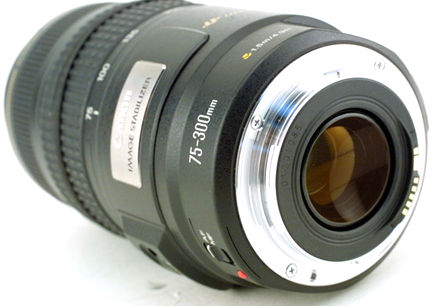 |
Canon EF 75-300mm f/4~5.6 II IS USM Telephoto Zoom Lens Marketed: 1995, Discontinued: 2005 |
Physically, it weighs heavier at 650g and can be easily differentiated from other Canon EF 75-300mm zoom lenses with an IS metal plate mounted onto the center section of the lens barrel. The zoom ring is narrower and the gold USM ring mark is moved to front section of the filter attachment ring. The center section has a control for adjustment or activation of IS function. It was hailed as the world's first interchangeable lens for SLR cameras that incorporates with a built-in an Image Stabilizer to counter camera-shake or more accurately, blur correction effect equals to an increase of two steps of shutter speed. The inclusion of this feature greatly expands the working range of handheld photography where typically associated blur image deliveries with slow speed film under low ambient light or other difficult conditions. Optically, in terms of elements and lens group, the lens is differed from other EF 75-300mm tele-zooms, but actually there are redesigned as six lens groups, of which the second group is for IS activation. Level of camera shake is detected by vibration detecting gyro sensors. In addition, a micro USM (Ultrasonic Motor) in the drive system ensures silent AF.
 |
Old Gate.. |
Introduction: What is the principle
of camera shake which results in blurred pictures? 1. I guess no photographer can
hold the camera perfectly still. 2. Whenever the camera moves with the shutter open,
the image on the film moves too. 3. The film records the entire process of movement
while the shutter is open, so the photograph is blurred. How to avoid camera shake
and blurred pictures? The rule of thumb to equalize these issue for decades by photographers
are usually use a tripod to hold the camera steady or sense the shutter speed drops
to a level not comfortable to hold and shoot steadily; use a fast shutter speed to
minimize the recording time of the film or simply use a flash. Each of these methods
have its advantages and the other way round. Tripods aren't easily portable, and
can't be used in some situations; High-speed shutters can't be used in even slightly
dimmer locations and flashes aren't allowed in many places, useless with distant
subjects and usually gives a flat impression.
 |
So, theoretically If a camera has a built-in function that compensates for the camera shake, you can be sure you'll have fewer blurred pictures. This idea became the concept behind development of a telephoto zoom lens with a built-in image stabilizer function to counter camera/lens shake. The Canon Image Stabilizer System actually has been used on video camcorders and binoculars has now been adapted for the EF lens. The result is the development of a new line, the IS lens (Image Stabilizer lens), distinguishing Canon from competing lens manufactures. Indirectly, development effort has also resulting in the emergence of a new class of EF lenses and realization of an IS functions within the lens has broaden the range of handheld photography. Naturally, telephoto and telephoto zoom lenses (esp. those with a slow starting aperture) will be the best lens group to incorporate this feature. The well-received Canon 75-300mm was chosen as the first Canon EF lens to try out consumer response to evaluate its marketing potential in 1995. |
 |
 |
TECHNICAL APPEAL |
Horizon.. |
 |
 |
 |
3. Image Stabilizer Control The image stabilizer starts to operate when the shutter button is pressed halfway. When hand shake is detected by gyro sensors, a signal is sent to drive the compensative optical system, which is controlled by the first high-speed 16-bit microcomputer to be used on any EF lens. The Canon EF 75-300 IS USM lens was the worlds first interchangeable lens for SLR cameras.
 |
However, there was also a Nikon compact Zoom 700VR (Zoom 105VR) lens on the market, and is the world's first lens shutter camera to feature Vibration Reduction function (released in April 1994). The following is a comparison of the two models (Highlighted numbers are Canon):- Focal length/Aperture: 75-300mm/4-5.6 / 38-105mm/4-7.8; Image stabilizing system Shift type (2nd group lenses) Shift type (3nd group lenses); Maximum correctable angle: ±0.70/ ±0.60; Verification of stabilization image through viewfinder:- Available / Not available; Operating noise from image stabilization operation:- Quiet / Noise from reduction gears; Type: Interchangeable lenses / Lens shutter camera SLR cameras |
The result makes it an excellent tele-zoom lens for PORTRAITS and OUTDOOR SPORTS . When use on digital cameras with focal multiplier of 1.6 (i.e, 5D, 20D, Rebel XT/350D, 10D, 300D, D1, D30, D60), the Image Stabilizer 300mm is equivalent to a 480mm on a film camera (like a cropped effect on astandard 35mm film, hehe..).
Below are extracts from a Q&A session on questions relating to effective application of IS in an optical lens for 35mm photography:-
Q: Is the image stabilizer effective
even for moving subjects? A: When tracking a fast-moving subject (planes, cars,
etc.), hunting might occur. Such panning shots will take practice.
Q: Can the image stabilizer be used while taking pictures on a moving boat, plane,
car, train, etc.? A: If the camera shake is not too severe, it can be corrected.
 |
 |
 |
 |
Q: When can't the image stabilizer be used? A: Turn off the image stabilizer before taking pictures in the following cases: 1. When using a tripod. (Using the image stabilizer while the camera is mounted on a tripod will cause the image stabilizer to misoperate.) |
2. During bulb exposures. (Using the
image stabilizer during a long exposure may cause the image to shift and blur.)
Q: Are there any other precautions for using the image stabilizer? A: When the
image stabilizer is turned on or off, the image may appear to shake in the viewfinder.
This occurs when image-stabilizing lens group is unlocked and centered. It does not
affect the actual picture. Also with certain EOS cameras, the image in the viewfinder
may appear to shake in the following cases: 1. After a picture is taken. 2. While
the camera's built-in flash recycles. 3. After a picture is taken in the DEP mode.
This momentary image shake does not affect the actual picture. When the self-timer
or EF-M is used with the EOS 55, the image stabilizer cannot be used.
Q: Is there any indication in the viewfinder or on the LCD panel when the image stabilizer
is on? A: Since the image stabilizer operation can be confirmed by looking at
the image in the viewfinder, there is no indication in the viewfinder or on the LCD
panel.
Q: What happens when the image stabilizer is not used? A: The image-stabilizing
lens group is centered and locked in place. The lens then becomes an ordinary 75-300mm
zoom lens.
Q: Why does the image stabilizer still operate for a while even after the shutter
button is released? A: If the shutter button is pressed and released repeatedly
within a short period of time, it would be inconvenient for the user if the image-stabilizing
lens group locked in place immediately after the shutter button is released each
time.
Q: When Custom Function No. 4 is on, how does the image stabilizer turn on? A: Pressing the AE lock button turns on the image stabilizer. With the EOS 55, pressing the shutter button halfway turns on the image stabilizer as usual and pressing the AE lock button activates the autofocus only.
Q: How different is this lens' image stabilizer from Nikon's Zoom 700VR image stabilizer? A: The Nikon also has an image-stabilizing lens group and gyro sensor. However, the Nikon uses a coreless motor to drive the image-stabilizing lens group while the Canon lens uses a moving coil to drive the lens group directly. Also, the Nikon's telephoto focal length is 105mm. Since Canon lens' telephoto length is 300mm, the image stabilizer control is more precise.
 |
|
Q: How superior is the Canon lens
compared to the Nikon Zoom 700VR? A: Since the image-stabilizing lens group is
driven directly, the response is faster and it can correct camera shake over a wider
frequency range.
Q: What is the camera shake correction range in degrees? A: ±0.7*. (The
Canon 12 x 361S binoculars is 0.9*.)
Q: What power source does the image stabilizer use? A: The camera supplies all
power.
Q: What is the power consumption? A: If the image stabilizer is used for 10 sec.
per picture, the battery life will be about.30 percent less than usual.
Q: What about the optical performance? Also, does the image stabilizer degrade the
optical performance? A: The optical performance is virtually the same as that
of the EF 75-300mm f/4-5.6 11 USM lens. The image stabilizer does not degrade the
optical performance.
Q: When the lens is not being used, must the Image Stabilizer switch be turned off?
A: When the camera is turned off, the image-stabilizing lens group locks. Therefore,
the image Stabilizer switch need not be turned off.
 |
 |
Front and rear view of the revised Canon EF 75-300mm f/4~5.6 II IS USM telephoto-zoom lens version |
Technical Specification for Canon EF 75-300mm f/4-5.6 II IS USM Telephoto Zoom lens: -
Type: - Autofocus lens type with manual focusing mechanism as well as Image Stabilizer feature
Focal Length: Variable focal length from 75-300mm
Focus Adjustment:- Autofocus ; single zoom ring with manual focusing ring design
Manual Focusing:- possible via AF/M switch;
Zoom Adjustment:- via zoom ring rotating type; indicative zoom settings: 75mm, 100mm, 135mm, 200mm, 300mm
Closest Focusing Distance:- 1.5m (4.9ft); Maximum Magnification:- 0.26X @300mm; MACRO setting indicated
Drive System:- Micro-USM, FTM may not be possible; Distance Scales: Nil
 |
|
Angle of View:- 27°~6°50' / 18° 11'~4° 35' / 32° 11'~8° 15'; Aperture range:- f/4.0 - f/32/f45 |
 |
 |
 |
Accessories:- Lens Cap/pouch E-58U; lens hard case: LH-C16II or LH-D18B; lens Hood:- ET-64; Soft Case:- ES-C17; Gelatin Holder III: (5); Holder IV: (4); Other Canon general filters and macro accessories. |
Previous | NEXT | 3/6 The MK III of the Canon EF 75-300mm f/4.0~5.6 III (USM) telephoto zoom lenses (current version)
Canon EF 75-300mm f/4~5.6 (1991) | EF 75-300mm f/4~5.6 USM (1992) | EF 75-300mm f/4~5.6 II (1995) | EF 75-300mm f/4~5.6 II USM (1995) | EF 75-300mm f/4~5.6 II IS USM | EF 75-300mm f/4~5.6 III (1999) | EF 75-300mm f/4~5.6 III USM (1999) | Canon EF 70-300mm f/4.5~5.6 DO IS USM (2004) | Canon EF 70-300mm f/4~5.6 IS USM (MK II) (2005)
 |
| Questions, Issues & Answers | Canon EOS-1 Series Message Board |
| Back | Main Index Page Canon EF lens Resources
| Back | Index Page The Canon EOS-1N Series Professional SLR camera
| Back | Main Index Page The Canon EOS-1 Series Professional SLR camera
| Questions, Issues
& Answers
| Canon EOS-1 Series Message Board
| Canon EF lens Board |
in a shared environment
| Free Trade Zone |
shared environment
This section serves as an Extension
to the Canon EOS-1N core site
Background
and Various Issues | The Basic Features & various Setup
Manual
& Auto Focusing
| Metering
Systems
| Exposure
Control
| Viewfinder
Optical
System
Flash
Photography
(with Speedlite
540EZ extension
& Selective info on Canon TTL Flash Models:-160E | 200E | 300EZ | 300TL | 420EZ | 430 EZ | 480EG | Macrolite | Other non-TTL Canon flash model
Reliability Issues:- Body Chassis | Shutter Unit | Electronic Circuitry | Film Transport & film handling Secondary Functions:- Custom Function Part One | Part Two | System Accessories:- Film Back Options - instruction for Command Back E1 | Macro/Close Up Part one | Part two and Part III Flash for Macro-Photography | Power Sources -BP-E1 | PDB-E1 | Focusing Screens | Remote Control with Wireless Remote Set LC-3 | System compatibility
Variants of Canon
EOS-1N:- Canon
EOS-1N RS
| Canon/Kodak Digital DCS-1, 3 -5 & 520/560 Series | Full Technical Specification | Main Reference Map / Nomenclature | Resource Centre:- Comparative Charts between EOS-1
& EOS-1N
/ or with its active Competition(s) (Nikon); Quick Operational
Reference
Card (278k Gif File); Listings of 7-segment
digital numbers/letters
appeared on LCD display panel/viewfinders (HTML page); External Link:-Instruction Manual (3.3MB PDF
file applicable for both Canon EOS-1N (RS). | Using EOS system for your photography | Bots & Nuts of EOS System - by Philip Chong
|
The Eyes of EOS - EF Lenses
A little OFF-TOPIC
SOME
Personal Thought
HOME - Photography in Malaysia |
A site co-developed by leofoo®™ & friends
Volunteered Maintainer(s) for the Canon EOS-1N Series Message Board: Philip Chong, Editor, Digital Camera Magazine; Vincent Thian, Photo Editor, Malaysian Bureau, Associated Press "AP", CYleow, Ex-photo Editor of local daily, The Star; Gary Rowan Higgins, Australia and other nice folks on the web.
Special Credit:- :Mr. Richard Yeow & Mr. Simon Wong from camera division of ![]() Marketing Malaysia, for
their continual effort in supporting development of this EOS/EF website. Others: All the nice people on earth who have contributed
their photos and pictures of personal works or product shots for the creation of
this site. Certain content and images appeared in this site were either scanned
from official marketing leaflets, brochures published by Nikon and/or contribution
from surfers who claimed originality of their own work for public publishing in this
website, where majority of the extracted information are used basing on educational
merits. The creator of this site will not be responsible for any discrepancies that
may arise from any possible dispute except rectifying them after verification from
respective source. Neither Nikon or its associates has granted any permission(s)
in using their public information nor has any interest in the creation of this site.
"Canon", "EOS",
"EF" "RT", "EOS-1n RS", "Booster
", "Macrolite", "fluorite", "Image Stabilizer"
& other applicable technical/business terms are registered trade name(s) of Canon
Inc., Japan. Site made with an Apple G5 IMac.
Marketing Malaysia, for
their continual effort in supporting development of this EOS/EF website. Others: All the nice people on earth who have contributed
their photos and pictures of personal works or product shots for the creation of
this site. Certain content and images appeared in this site were either scanned
from official marketing leaflets, brochures published by Nikon and/or contribution
from surfers who claimed originality of their own work for public publishing in this
website, where majority of the extracted information are used basing on educational
merits. The creator of this site will not be responsible for any discrepancies that
may arise from any possible dispute except rectifying them after verification from
respective source. Neither Nikon or its associates has granted any permission(s)
in using their public information nor has any interest in the creation of this site.
"Canon", "EOS",
"EF" "RT", "EOS-1n RS", "Booster
", "Macrolite", "fluorite", "Image Stabilizer"
& other applicable technical/business terms are registered trade name(s) of Canon
Inc., Japan. Site made with an Apple G5 IMac.


